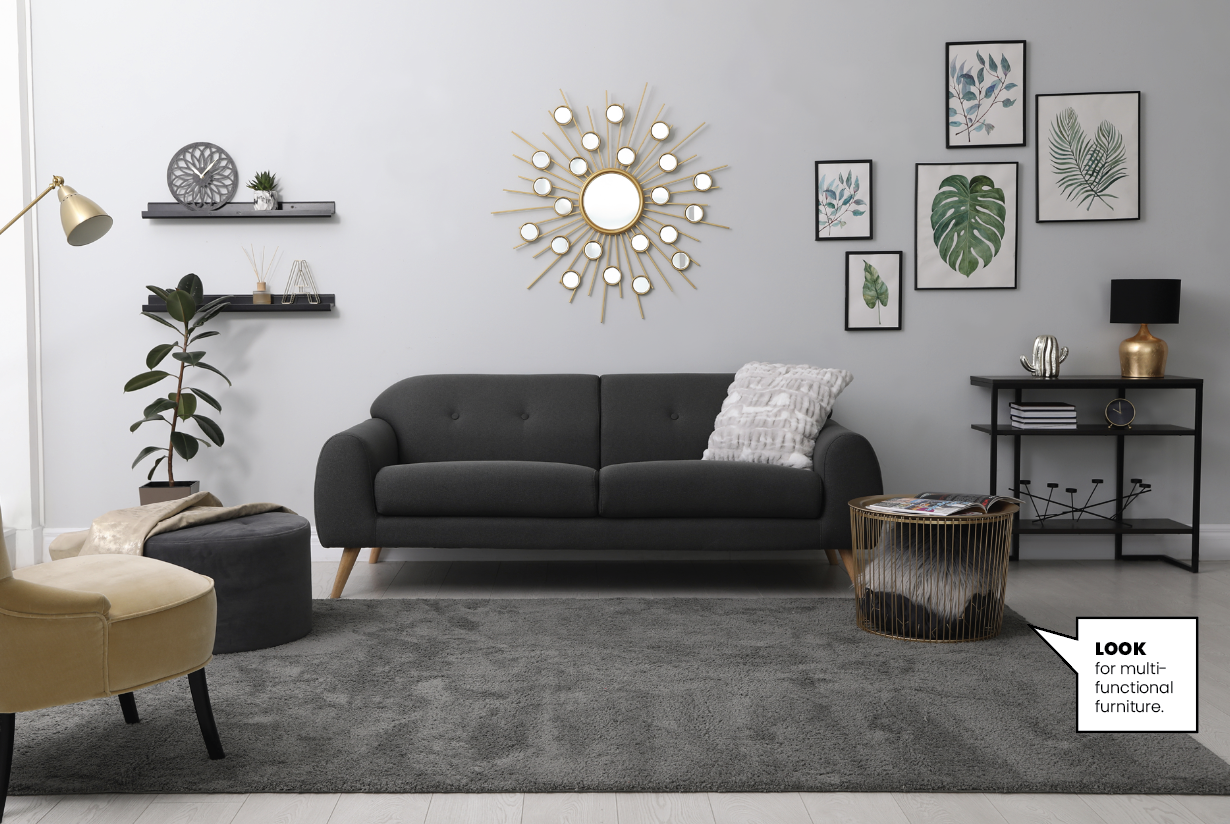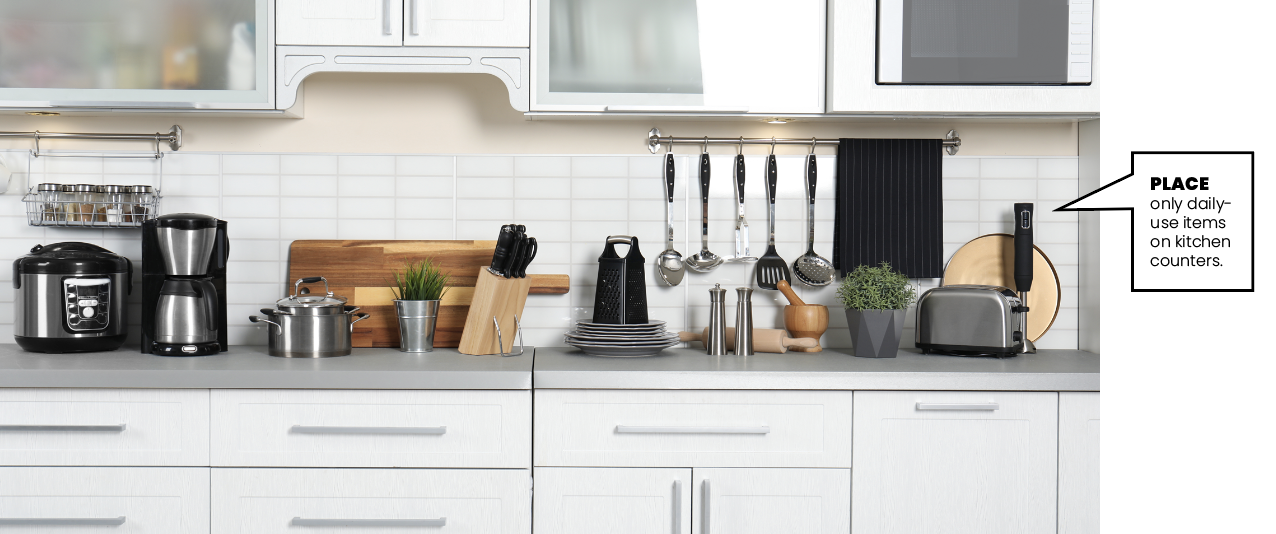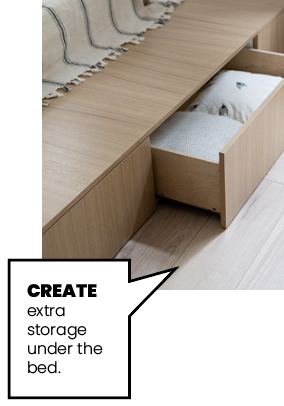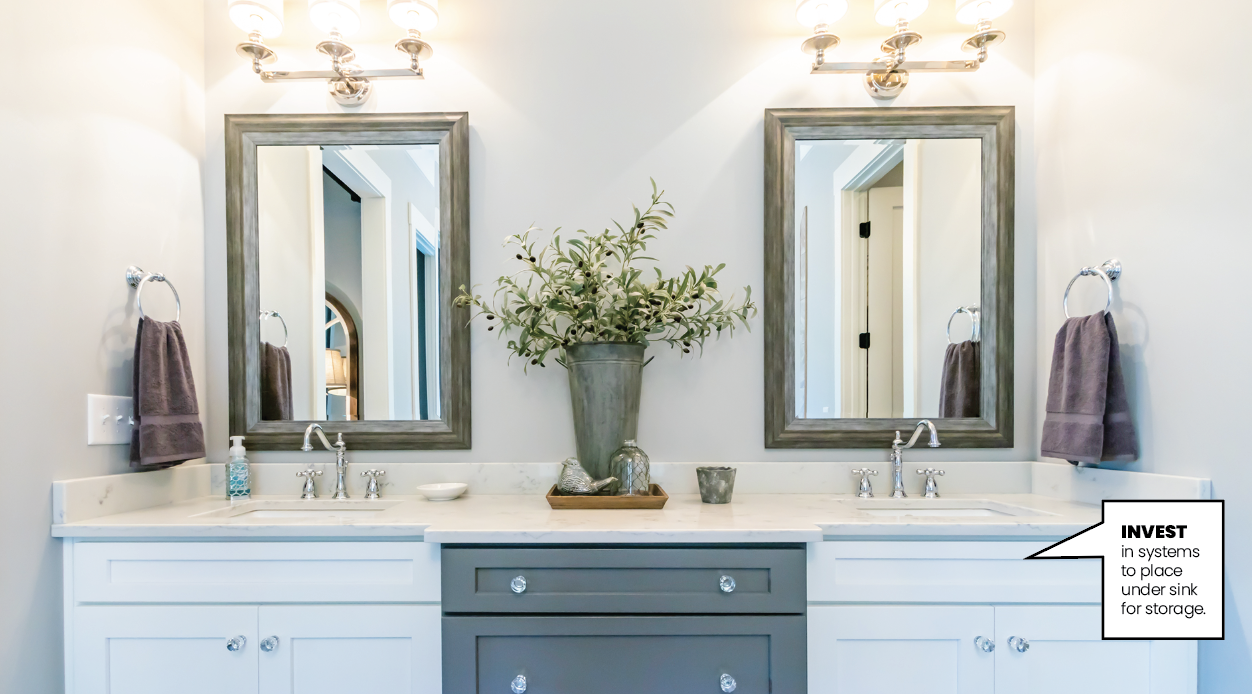Make your home the best it can be. Organize your space to take control of your possessions and your time. Even if you aren’t someone who sorts and declutters for fun, fear not! We’ve talked to three organizing experts to help you get your home in order and optimize its functionality.
Get Started and Go for a Goal.
Before you begin organizing, think about how you want to use your space. Erin Martin, owner and professional organizer of Amplo Organizing, suggests keeping a goal for the room in mind. Martin divides organizational styles between “all out” versus “all in.” People who are “all out” like to keep their possessions in sight. “All in” people prefer a more minimalistic approach and like items to be put away.
“Perfection can lead to indecision, so I vote for good enough,” says Vali G. Heist, certified professional organizer and owner of The Clutter Crew. She breaks organizing into four premises: “simple is best, like with like, a home for everything, and if it takes less than 60 seconds, just do it!” She recommends decluttering first before organizing.
“There are so many different styles, such as essentialism, minimalism, home editing,” says Yuriko Beaman, M.S., owner of Joy & Space LLC. She suggests trying a consultation with a home organizer to “see if that approach is best for you. Many organizers offer a variety of options to support you, so you can find the help that suits you and your budget.”
Love that Living Room.
For living rooms, “make sure it’s relaxing, fun and family-oriented,” says Heist. Use those activities as an organizing strategy. Since this is a shared space, Heist suggests gathering the family together and asking them what they want to change, add or remove from the room.

Beaman suggests asking these questions: “What would I prefer to do in my living room? What are the things that I would like to have that are a part of my ideal lifestyle?” Think in categories. Keep similar items together and “keep the items in the living room that are supporting you and your family’s activities.”
“The living room is a great example of a space where you want to look for multifunctional furniture,” says Martin. She encourages people to think about everything they own and how it works for them.
Clutter-Free Kitchen.

“Organize every room in zones or stations, so that the functions someone performs in the room are easy, efficient and simple to do,” says Martin. If a morning cup of coffee is an integral part of your day, she suggests creating a countertop coffee station with your coffee maker and supplies within arm’s reach.
Heist recommends people empty the cabinets and drawers, “and only put back what you will use, have used, or is worthy of space in your kitchen.” She advises placing only daily-use items on kitchen counters. “The kitchen is also the hub of the home: maybe a mail-sorting station and the family calendar should have a place of honor.”
Beaman suggests having all the cooks in the home participate. “One of my favorite queries is to ‘Pick out your go-to knife or spatula.’ Make sure you keep everyone’s favorite and let go of the items that no one is using.” Heist agrees: “a good knife can do the job of 10 gadgets!” Once the favorites have been identified, Beaman advises working from big items to small items.
Peaceful Bedrooms.

Create a bedroom to “support your optimal sleep hygiene,” says Beaman. Heist agrees: “The bedroom is all about sanctuary and a place to rest, so go for calm and uncluttered.” For starters, Heist suggests decluttering closets and removing unwanted clothing.

Both Beaman and Heist agree that the bedroom is not the place for exercise equipment or a home office. If space is at a premium, Heist suggests using a screen to block off the spaces. Beaman says that a bedroom should be “associated with sleep, rest, relaxation, a healthy work-life balance and healthy habits.”
Martin recommends using the space under the bed to store off-season clothing or items that aren’t frequently used. Mount or hang items on the walls to get them off the floor. “Look up,” she says, “focus on wall space.” Martin also recommends over-the-door shoe organizers. Besides shoes, these can be used for pantyhose, beauty supplies and more.
Heist suggests a clothes tree to corral clothes that will be worn again. For easy sorting, she recommends a large hamper for laundry and a donation bag for unwanted items.
Blissful Bathrooms.
When it comes it bathroom products, “less is more,” says Heist. ”Keep only the products that you use, love and can’t live without.” For an easy-to-clean vanity countertop, she suggests using trays for similar items.
“Bathroom spaces usually get the most cluttered/messy, especially the storage under the sink,” says Beaman. She suggests separating items by category, such as cleaning supplies and hygiene items. Each category can be stored in separate containers or separate storing areas.

For under the sink storage, “there are a lot of cool systems that you can buy to install or place under the sink that will help you use that vertical space,” says Martin. Some feature pull-out baskets to reach items at the back of the cabinet. To avoid buying duplicates, make everything “accessible and visible as possible,” says Martin.
Garage and Basement.
“Garages and basements can become unused and unloved space,” says Beaman. These open spaces can be “the dumping grounds for delayed decisions on whether to get rid of items,” adds Heist. Instead of focusing on the past, she advises looking to the future. “What are your goals, and who will use the space?” asks Heist. Let go of anything that doesn’t fit that vision.
Consider your family’s needs, such as “another space for your kids to play or maybe you’d love to carve out a little meditation space just for you,” says Beaman. She encourages people to visualize that goal.
Both Heist and Martin recommend dividing basements and garages into zones. Possible basement zones could include storage, crafting, relaxation, a tool bench or exercising, according to Heist.
Since basements can be damp, Martin advises using water-resistant containers for storage. Shelving can maximize storage space and keep items off the floor. Avoid storing items that are “very susceptible to moisture, like paperwork and documents and family photos,” adds Martin.
In both the garage and basement, Beaman recommends gathering “similar items together so you have a better idea of the quantity that you need to keep. “Keeping similar items together in storage makes it easier to locate them.
“You want your garage to function,” says Martin. She suggests a workbench for tools and a zone for lawn and garden items. “Be very tactical about what goes in there.” For off-season items, Martin recommends a ceiling-mounted storage rack and shelving for vertical storage. Labeled clear plastic bins will make it easy to see what’s being stored.
Reuse and Repurpose.
Before you invest in storage containers, Martin suggests shopping your home. It’s fulfilling for people to reuse an item, she says. “They have reinvested in what they already own.” Baskets can be used to store craft items or personal care supplies. Lazy Susans can be reused in medicine or spice cabinets.
“You can repurpose just about anything, but only spend time on repurposing the things that you really want to see in other areas of your home,” says Beaman. She recommends reusing shoe boxes and gift boxes as hikidashi boxes. Named after the Japanese word for drawer, these boxes are sturdy and elegant.
To give new life to old furniture, Heist suggests that a former kitchen table can become a desk, and wardrobes and buffets can be used to store craft or office supplies. For gardening enthusiasts, antique pots and old boots can be used as planters.
If you have a collection of kids’ art, Martin recommends making pictures of the artwork into a coffee table book. This can be a great way to display and preserve it.
Try to recycle unwanted items. “You can recycle used ink cartridges at Staples and used underwear and socks at knickey.com. Both companies will give you a reward for recycling,” says Beaman.
Cool Containers.
Like Martin, Heist also suggests shopping your home for containers. For open areas, she recommends pretty baskets, wood containers or antique dishes or trays. For kids, Heist advises selecting open containers and shelving, and wall hooks for ease of putting things away.
Beaman suggests testing out storage solutions. Start with bags and boxes already in your home. “Once you know that the size and space is right, start looking for bins and boxes that are easy for you to use.”

Martin recommends using shoe shelves on top of a desk to store papers and art supplies. She also uses cubby shelves for a variety of purposes, such as placing the cubby on its side in a closet under hanging clothes.
Choose a storage container that works for you. “A storage container might be lovely to look at but if you can’t unlatch it easily, you may be less likely to use it,” says Beaman. “Once you know what’s best for you and your space, check out etsy for unique options.”
Tackle a Big Mess.
If you have areas in your home that feel insurmountable, take heart. “Remember that it took years to fill your home with stuff, and it will take more than just a weekend or two to really do it right and make a difference in your life,” says Heist.
“Clutter is overwhelming,” says Beaman. “It increases the stress hormone cortisol so take comfort in knowing that there is a biological basis for how you feel.”
Martin advises people to “first take a step back and think about what they want.” Once you get started, there’s no wrong place to begin. “Work left to right or right to left, around the space, usually starting with creating a pathway to walk.”
You can also begin with your strengths. “Start with an easy category, such as clothes. If there is a room, basement or guest room that has been taken over by clutter, approach it category by category,” says Beaman.
“It does take effort, but anything that is life-changing will. You can do this!” encourages Heist. “There could be a first pass and a second pass before you are really satisfied. Imagine your home how you want it and work toward that goal with a vengeance.”
Give yourself credit for your hard work. “Remember to take breaks and have a reward planned for after you are done,” says Beaman.
Have confidence and discover what works for you. “There’s really no wrong way to organize. It’s very much dependent on your goals and your ability to be creative,” says Martin.
Sources
Amplo Organizing
Gilbertsville | 484.574.5672
amploorganizing.com | FB @amploorganizing
The Clutter Crew
Mohnton
610.914.3483 | thecluttercrew.com
Joy & Space LLC
Reading
484.352.2844 | joyandspace.com
















